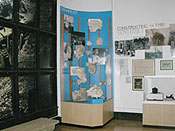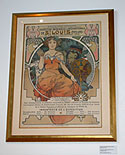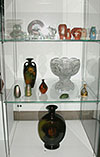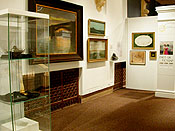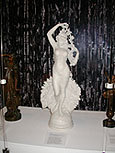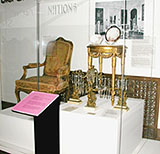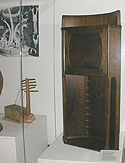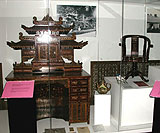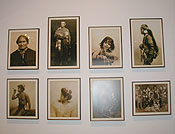The browser will either open the file, download it, or display a dialog.
|
||||||||
|
The 1904 World's Fair: Looking Back at Looking Forward Celebrating the 1904 World's Fair The 1904 World's Fair: Looking Back at Looking Forward |
||||||||
| The Louisiana Purchase Exposition of 1904 embodied the interests and aspirations of a nation at the turn of the century. Held in St. Louis, the symbolic gateway to the West, the Fair trumpeted the United States' sense of success in transforming their western territories from an untamed savage wilderness into a civilized paragon of commerce, and celebrated in elaborate faux palaces, western civilization's achievements in science, agriculture, technology, and art. The adjacent mile-long Pike featured thrill rides, special displays, and "living exhibits" of peoples from around the world, indulging a taste for things exotic and entertaining. Like the expositions that preceded it, the St. Louis World's Fair emphasized progress, grandeur, novelty, and above all, overwhelming size and scale. Constructed on twelve hundred acres of converted forest land, the fairground's many temporary palaces, buildings, exhibits, and landscapes were constructed at a cost of twenty million dollars. Although it did not eclipse the attendance of the longer-running Paris Exposition Universal of 1900, the Fair in St. Louis attracted an estimated twenty million visitors during the seven months its gates were open, making St. Louis a center for the meeting of ideas, and the dissemination of fashion, taste, and technology.1 | ||||||||
| The Missouri Historical Society's exhibit, The 1904 World's Fair: Looking Back at Looking Forward, transports the visitor to St. Louis circa 1904, detailing the event's planning, construction, and content. Just as the Fair was marketed to the average person, so the exhibit, held to mark the Fair's centennial anniversary, unfolds in a manner engaging to both the scholar and casual visitor. Progressing through two galleries and a connecting hallway, the exhibit includes photographs, documents, and judiciously chosen artifacts, each accompanied by a concise and informative label. In a design choice that effectively increases the appeal of the exhibit to children as well as adults, the exhibit also includes interactive displays and "Pillars of Knowledge." These stations, located throughout the exhibit, contain viewing windows placed at a height accessible to visitors of all ages that feature fun facts. For example, there is a segment on Mr. Ferris's wheel originally designed for the Chicago World's Columbian Exposition of 1893 in a bid to outdo Paris's Eiffel tower, as well as interesting artifacts such as a child's strawberry-shaped coin purse, a miniature replica of the Japanese tea house, and a hand-held stereograph through which three-dimensional pictures of the Fair can be viewed. The elements of the exhibit are well chosen, artfully juxtaposed, and knowledgeably elucidated, and combine to offer the viewer a rich slice of turn-of-the-century Americana at the St. Louis World's Fair. | ||||||||
| The first room of the exhibit is chiefly occupied with the themes of planning, design, and construction and serves as an effective backdrop for the content of the exhibit's main hall. Upon entrance, to the left and right of the viewer, two large windows are filled by multi-paneled backlit scenes detailing two stages of the Fair's construction. To the left is a depiction of the clearing of Forest Park, the vast wooded and swampy region which was chosen to become the fairgrounds. Tree stumps, not yet dynamited for complete removal, dot the barren landscape and the size of the floor-to-ceiling photographic enlargement impresses upon the viewer the immense scale of the project and the sheer willpower necessary to transform the wooded, undeveloped region into the manicured grounds of the Fair. Nearby, a segment devoted to the contributions of the 10,000 laborers who undertook the feat emphasizes the scale of their accomplishment and stresses the symbolism in their transformation of Forest Park "from a rough wilderness into the largest World's Fair in history."2 Occupying the opposing window, a scene of equal size portrays the construction of a Fair building attended by a crowd of onlookers. Again the size of the photographic enlargement is effective in suggesting the magnitude of the undertaking and the brute physical force and determination required for the construction of the Fair. As the largest international exposition yet planned, the St. Louis World's Fair adopted the classically inspired Beaux-Arts architecture, expansive lagoons, and wide avenues made popular at earlier expositions but distinctly altered the site plan along which they were arranged. | ||||||||
| Mounted on the wall of the exhibit's first gallery is a particularly interesting line drawing by Isaac Taylor, the director of the division of works, that details the original site plan as published in a 1901 edition of the World's Fair Bulletin. Based on the Beaux-Arts strategy of axial planning, the main grounds were conceived as a series of avenues and lagoons radiating like the folds of a fan around the central focal point of the Grand Cascades at Festival Hall, allowing for numerous picturesque views up and down the multiple roads and waterways. The elaborate Beaux-Arts palaces which dominated the Fair's landscape were designed to be monumentally impressive but ultimately temporary structures, and when one visits the Forest Park of today, only the Palace of Art remains as the St. Louis Art Museum. Noteworthy as the most expensive building at the Fair, constructed at a cost of nearly one million dollars, and the only building designed to be fireproof and permanent, an architectural drawing for the Palace of Fine Arts by Cass Gilbert is also included as part of the exhibit's background information. The temporality of the vast majority of the Fair's buildings, however, is represented in another remarkably well-conceived and successfully implemented segment of the exhibit. Wittily entitled, "Ready-Mixed Grandeur," this section deals with the mass-produced ornamentation constructed for the Fair's main palaces and also stands for the larger phenomenon of the many temporary Beaux-Arts palaces, Venetian lagoons, Italian fountains, and other elements hastily co-opted from European architectural history and just as quickly dismantled after the Fair had ended. (fig. 1) Made out of a mixture of plaster, cement, glycerin, dextrose, and shredded hemp, this material, called staff, was poured into molds to quickly produce sculptural ornaments for the facades of the main palaces. The staff sculpture fragments included in the exhibit were excavated from Forest Park, ironic ruins of America's past, and are artfully displayed against photographs depicting a variety of freshly made pieces awaiting installation. At waist height in front of the display case, a lion's head invites viewers of all ages to pat its head to experience the smooth creamy surface of pourable sculpture. | ||||||||
|
The exhibit's first gallery also addresses the efforts of David R. Francis, a seasoned politician and president of the Louisiana Purchase Exposition Company, to promote the Fair internationally through the use of graphic art. A poster and graphic insert included in the gallery suggest a particular approach adopted by Francis in the marketing graphics he commissioned for the wide-reaching campaign. While St. Louis may not have been able to compete with Paris as a center of fashion, it was the gateway to the Wild West, and both images play to romanticized notions of the subdued savage. The tinted graphic insert distributed in the 10 May 1903 issue of New York World features an especially evocative composition by Dan Smith. Seated in a canoe, a solitary Indian floats aimlessly on one of the Fair's faux lagoons at sundown, a contained and subjugated curiosity, while the Old World grandeur of the Fair's Beaux-Arts palaces soar triumphantly behind him. Further suggesting the popularity of the motif of the defanged West in promotional material prepared for the European campaign is the famous lithographic poster by Alphonse Mucha designed to advertise the Fair in France. (fig. 2) Although hung a bit high, the aestheticism and symbolism of the composition can be powerfully felt. The rigid bearing and alabaster complexion of the female figure serves as an apt metaphor for the fashion, beauty, discipline, and progress that the "ivory city," as the Fairgrounds came to be known, wished to embody. Conversely, the lax pose of the brooding, impotent Native American who submissively places his hand in hers, serves as a romantic invocation of the Wild West tamed for European consumption. | |||||||
| While the romanticized notion of the subdued savage and bridled West may have appealed to a European audience, Americans were more likely to be attracted to the idea of the St. Louis World's Fair as the height of modernity and fashion. This susceptibility can be seen in the posters which were once part of the domestic marketing campaign conducted by Railroad companies which competed hotly for the business of those traveling to the Fair. One large advertisement for the Missouri-Kansas-Texas Railway permanently installed against a translucent window in the connecting hallway associates traveling to the Fair with the ideas of youth, beauty, and vivacity embodied by the "Gibson" girl. Like a second ad for a competing rail line exhibited in the following gallery, these domestic advertisements take a fashionable, thoroughly modern "Gibson"-type beauty as their marketing emblem and graphically illustrate the nuances between domestic and international marketing strategies. | ||||||||
| While the MKT Railway ad is not officially part of the exhibit (but is included by happy accident as part of the scheme in the connecting hallway), the space is predominantly devoted to memorabilia associated with the exhibits at the Pike. This portion of the exhibit is fairly small and is successfully installed, similar to the Pike's location at the Fair itself, slightly separate from the main show. The mile-long Pike was considered the carnival space of the Exposition and could be entered freely by visitors, although each of the fifty different amusements charged individual admission fees. Here the fairgoer could buy tickets to the Cairo exhibit, a pass to Mysterious Asia and Empire of India, a trip through the Tyrolean Alps complete with reconstructed mountains, or a pass to the Magic Whirlpool, one of the Pike's thrill rides. Memorabilia from these and other amusements are included in the room's display case. Covering the opposing side of the gallery are two wall-size photographs of fairgoers enjoying rides on an elephant and a camel, one of the exotic novelties on the Pike, in the company of a foreign worker dressed in his native costume. "Known as the street of controlled chaos," the wall label explains, "Fairgoers on the Pike enjoyed a thrilling array of spectacles in relative safety." | ||||||||
| Passing through the connecting hallway, the visitor enters the exhibit's main showroom. While the previous gallery and hallway contain a great deal of archival information and black and white photographic reproductions, the visitor is greeted in the main showroom by a rich display of color, artifacts, and sound. Although the exhibit is not based upon an art historical premise, the elaborate visual nature of the Fair lends itself well to art historical purposes. Furthermore, as the Exposition's president, David R. Francis, recalled in his history of the Fair, "At no previous exposition did art receive so much recognition and attention,"3 and the significant role occupied by art itself at the Fair is well reflected in the present exhibit. | ||||||||
| Of particular interest is the precedent-setting decision by the Fair's organizers to exhibit carefully selected examples of the applied arts alongside the traditional high arts in the Palace of Fine Arts, lending official credence to the contemporary Arts and Crafts and Design Reform movements. As Beverly Brandt argues in her article, "Worthy and Carefully Selected: American Arts and Crafts at the Louisiana Purchase Exposition, 1904," public exhibitions were crucial to the diffusion of these movements.4 While guilds and regional Arts and Crafts societies could exhibit locally and occasionally publish select photographs in trade journals of the period, international expositions allowed for broader exposure and a larger exchange of ideas. While the applied arts were also exhibited in other areas, especially the Palace of Varied Industries and the Palace of Mines and Metallurgy, the organizers of the World's Fair at St. Louis placed a pioneering emphasis on the equality of the arts. For the first time at an international exposition, the contemporary Design Reform movement was presented as artistically valid and a forum was provided in which to present Arts and Crafts pieces not merely as products, but works of art. This development has been hailed as a milestone in the history of the American Arts and Crafts movement,5 and while the exhibit includes many examples of fine, decorative, and popular art both for sale, and in the case of the first two categories, for exhibition, the full significance of the St. Louis World Fair's as an important moment in the history of art could be more fully and extensively asserted. | ||||||||
| Of the exhibit's several cases devoted to art at the Fair, one display features the applied arts exclusively and includes examples of both artistic and popular decorative wares. (fig. 3) Representing popular decorative art at the Fair are several examples of moirage ware, a gaudy Japanese porcelain widely available for purchase at Fair Japan on the Pike6 which, the accompanying label informs us, owed its popularity to its promise to bring elegance and exoticism into the American home. Also included in the display are several examples of Weller ware. The Weller Pottery working exhibit located outside of the Palace of Mines and Metallurgy sold artistic pottery souvenirs which fairgoers could observe being designed, thrown, and decorated, in keeping with one of the Fair's main goals of education. Intermingling with these items are examples of higher decorative art. When Halsey Cooley Ives and Frederick Allen Whiting, the two Fair officials who held ultimate sway over the applied arts division of the Palace of Fine Arts, began to lay plans for the constitution of this division, they made a concerted effort to curb the number of ceramics to be exhibited. As a result, many art pottery firms were limited in their exhibition at the Palace of Fine Arts or were excluded altogether, leading many firms to seek additional exhibition opportunities in other departments such as the Palace of Varied Industries and the Palace of Mines and Metallurgy.7 Despite the best efforts of Whiting and Ives, however, ceramics occupied a prominent place at the Fair; and included in the display case of the present exhibit are examples from several of the most significant art pottery firms to have shown there. The Grueby Faience Company, the firm which enjoyed the most success at the Palace of Fine Arts and which was not by coincidence also located in Boston—the same city where Whiting served as secretary for the local arts and crafts society—is represented by a scarab beetle paperweight.8 Rookwood, another famous art pottery firm from Cincinnati, Ohio, is represented by a high-gloss vase decorated with a leaf motif, the type of standard ware vase which Whiting deliberately sought to exclude from Rookwood's exhibit at the Palace of Fine Arts in favor of a selection of "undecorated pieces" with "dull glazes."9 Also represented is an Indianhead vase by Roseville, a firm which suffered the misfortune of being excluded altogether from the Palace of Fine Art.10 While the St. Louis World's Fair was a crucial moment in the attempt to develop a distinction between artistic pottery and, in the words of one Fine Arts Commission jury member, "art produce,"11 this development is not fully elucidated, nor is the Fair's significance as the ground-breaking moment in which select examples of the applied arts were exhibited for the first time alongside the traditional fine arts. From the perspective of the art historian, this is an unfortunate omission. | ||||||||
| One important American decorative artist who is singled out for special treatment, however, is Louis Comfort Tiffany. In between a display of popular souvenirs and a section featuring St. Louis artists at the Fair is a small display case containing four works by Tiffany and Co. The case, accompanied by a well-written and informative wall label, includes a sterling silver Renaissance-inspired vegetable dish, a dragonfly brooch, a brooch of leaves and berries similar to one exhibited at the Fair, and an ivory tusk inkstand which bears the "fleur-de-lis" mark, Tiffany's special imprint for the Fair. While the pieces are perhaps not the most stunning examples of Tiffany and Co.'s work, the accompanying information lucidly describes Tiffany's significance as a purveyor of fine decorative art to "Gilded Age" families and emphasizes the significance of the Art Nouveau movement as a revival of hand craftsmanship and a revolt against mass production and marketing. | ||||||||
| Fine art exhibited at the Fair is represented in a section that focuses specifically on the contributions of St. Louis artists. (fig. 4) Among the pieces in this section is an oil on board painting by George Catlin, entitled St. Louis in 1832, which was included as part of the Missouri Historical Society's anthropological display in the Administration Building. Also included are four paintings by Edmund Wuerpel, a leader in the St. Louis arts community who also exhibited at the Paris Exposition of 1900, and a composition entitled, The Bridge, by Frederick O. Sylvester, one of St. Louis's most significant artists from the early twentieth century. In addition, there is a small bronze, Bust of a Baby, by Bessie Potter Vonnoh, an impressionist sculptor who was the only female artist from St. Louis to exhibit in the Palace of Fine Arts. While these pieces were intended for exhibition, fine art created for sale at the Fair is represented in another of the gallery's displays which includes a marble sculpture of Aurora. (fig. 5) Purchased from an Italian display at the Palace of Manufacturing, this sculpture was part of a commission by ten Italian marble firms of Florentine sculptors to manufacture more than 1,500 neo-classical sculptures. The resulting pieces, valued collectively at one million dollars, were exhibited closely together to give the prospective buyer the impression of being lost in an opulent forest of marble. Well-to-do Fair visitors purchased these sculptures for their homes and gardens; and some of the most fashionable pieces even bore lists of who had purchased replicas and how many copies had been ordered. | ||||||||
| The role of art exhibited by foreign governments is explored in a section entitled "Nations on Display." Invoking the Louis XVI style, a period in which French artisans dominated the decorative arts, the French government sent a reproduction of the Chateau Grand Trianon at Versailles, which David R. Francis deemed representative of the "climax of luxurious elegance."12 With a photograph of the original installation in the background, the display includes an armchair and a table from the pavilion. (fig. 6) Also included are several pieces of Limoges china. At the Limoges display, well-to-do fairgoers could order specialized patterns or could immediately purchase standard pieces such as this rose-pattern set designed by Theodore Haviland. In a separate section representing Germany is an example of German-designed furniture and a collection of ethnographic artifacts from Germany's East African colony, Tanzania. (fig. 7) Germany, the labels explain, wished to assert its progress, achievements in industry, and modern sensibilities in art and design, and set out to do so in the most elaborate manner possible. By express order of the German emperor, German artisans and craftsmen made a concerted effort to demonstrate to America the most modern designs for handcrafted and mass-produced furniture. Representing this in the present exhibit is a yellow-ash corner cabinet inlaid with maple, mahogany, and palisander designed by Albin Müller, and which was originally displayed as part of a gentleman's study exhibited in the Palace of Varied Industry. Art and industry were only partial components of Germany's larger scheme to assert to the world its competitiveness as a major international power, however, and also included in the exhibit are several Tanzanian artifacts which were originally part of the German Agricultural Society's East African Exhibit in the Palace of Agriculture. Included in the present exhibit are artifacts such as a Tanzanian headdress, a warrior shield, a hunting spear, and a harp made from an animal skin. The original exhibit also included photographs, paintings, and agricultural products in a grand-prize-winning effort which the accompanying wall label effectively expounds upon. "The message was clear," the label emphasizes. "Imperial Germany had extended her power and influence and would be a major competitor in the race for the world's available resources." | ||||||||
| Representing the interest in the Orient are artifacts from the Chinese and Japanese exhibits. The St. Louis World's Fair marked the first time China officially participated in an international exposition. A replica of the summer palace of Prince Pu Lun, who visited the Fair personally, was constructed for the occasion and the Chinese government also held an exhibit in the Palace of Liberal Arts. Varied examples of Chinese art are represented in the current exhibit by an elaborately inlaid desk and chair, and a pair of women's silk slippers, loose-bound rather than the tight-bound shoes which seemed cruel to western audiences. (fig. 8) Japan is represented by several smaller objects, including memorabilia from the country's various displays and a Japanese teapot exhibited at Fair Japan on the Pike. Located in a nearby "Pillar of Knowledge," a miniature replica of the Japanese tea house can also be seen. Considering the amount of scholarly attention given to the aesthetic influence of Japan upon western art and architecture of this period, and to the nature of international expositions as one of the chief means of mass exposure to these influences, it would have been compelling to see Japan's role at the St. Louis World's Fair explored more extensively. | ||||||||
| A more subtle aspect of the exhibit is the seamless integration of photography. Documentary photographs are included throughout to supplement the artifacts and information displayed, couching them within their context at the Fair and in several instances providing the viewer with an idea of the setting in which the artifacts were originally located. Also of particular interest are the artistic photographs taken by the Gerhard Sisters. (fig. 9) As the first women to operate a photography studio in St. Louis, the two sisters were especially interested in creating photographic studies of visitors from around the world who lived and worked on the Pike and in the Anthropology Department's exhibits of native peoples. Taken in the women's studio, the subjects were effectively removed from the context of the "controlled chaos" of the Pike and lit with natural light to explore their unique facial features and distinctive dress. Including photographs of subjects such as a Bagabo chief, Japanese geishas, a Bedouin child, a Patagonian giant, and the captive Apache chief Geronimo, these sensitively recorded photographs serve as captivating images of people from exotic locales who lived in St. Louis during the World's Fair. | ||||||||
| A section entitled "Viewing the 'Main Picture,' Popular Art and the Marketing of the World's Fair, 1904" takes a close look at the artistic recording and marketing of the Fairgrounds.13 The ideas in this section are further elaborated in an essay in the Missouri Historical Society's quarterly magazine, Gateway Heritage, written by director of museum collections Andrew Walker, and which can be purchased at the museum's gift shop. Illustrated with paintings and prints largely drawn from the Historical Society's own collection, Walker constructs a carefully argued and effectively illustrated account of the employment of popular paintings of the fairgrounds. (fig. 10) Charles Graham's panoramic view of the Fair, which became perhaps the most well-known image of the fairgrounds after it was published as a 35,000 edition lithographic poster, is included in this section as well as the works of several other artists who depicted the fairgrounds, but by far the best represented artist in this special feature is John Ross Key. Key created fifteen impressionistic oil-on-canvas paintings of the picturesque views created by the Fair's unique ground plan, several of which are included in the exhibit. Eight of Key's Fair images became particularly well known through the mass distribution of printed editions commissioned and published by a Chicago lithographic company. For eight weeks during the middle of the Fair, the St. Louis Globe-Democrat released a new print in their Sunday paper. These images, which recorded the ultimately ephemeral fairgrounds in all their glory, became popular and affordable "artistic" keepsakes. Each week the Globe-Democrat plastered the city with posters advertising the image that would be available in the following Sunday's edition. This process of image making is especially well-illustrated in the exhibit's inclusion of Key's composition, Looking towards the Pike between the Palaces of Transportation and Varied Industries, in its three iterations—the original oil painting, poster advertisement, and subsequent lithographic print. | ||||||||
| The importance of the architecture and landscaping at the Fair, and the significance of the site plan along which they were constructed, is highlighted in the comments of David R. Francis, which Walker includes in his essay. "I feel when I stand on Art Hill," Francis stated, "and view the panorama spread before me, that I have seen a masterpiece of architectural achievement. It is as if the symbolized Genius of construction stood at my side and slowly unfolded her bejeweled fan, on which are embossed in ivory, silver, and gold the most exquisite creations of the art."14 Walker effectively argues both visually in the exhibit, and more extensively in his essay, that these images contributed significantly to the visual culture of the Fair and were successfully employed to promote it; they served as a pictorial collectible for those who attended and as a surrogate experience for those who could not, and "outline[d] a kind of nationalist symbolism that equated monumentality with American progress."15 | ||||||||
| In his article, Walker includes a quotation that contains both the eloquent impression of one Fair visitor and a suggestion of the significance that studying the Fair holds for today's visitor. "Thus, the first impression of bewilderment gives way to wonder and at last to a new conception of the magnitude, the variety, and the richness of our land and of our people," the writer surmised. "Any American citizen who studies it all intelligently will carry away a new and enlarged notion of his country, of his countrymen, and of the time in which he lives; for the Fair is the best ocular expression of these large facts that has ever been made."16 By selectively choosing items from their own and other local collections, assembling these artifacts, and illuminating them with informative wall labels, the exhibit's curators have reconstructed a condensed version of the St. Louis World's Fair that offers to the viewer an effective introduction to the construction, content, and visual culture of a monumental event. While the exhibit lacks an official catalog, its potential reach is greatly enhanced by its accompanying web-site, which features photographic reproductions of many of the show's highlights accompanied by the artifacts' labels.17 Additionally, the Spring 2004 edition of Gateway Heritage contains supplemental articles and information and will be of interest to anyone wishing to learn more about the St. Louis Word's Fair. The efforts of the show's organizers to incorporate the role played by art at the Fair into an exhibit which holds as its broader aim the consideration of a multitude of historical concerns within a limited gallery space is admirable. Although the exhibit could be more comprehensive in addressing the presentation of art at the Fair and in expounding upon its impact on the American art scene, overall the exhibit is remarkably successful in its efforts to reconstruct the content and atmosphere the Louisiana Purchase Exposition. In this way, the exhibit serves as a model of its kind as it carefully reconstructs a major international exposition and attempts to acknowledge the many roles played by art and visual culture at this important turn-of-the-century event. | ||||||||
|
|
||||||||
| Sarah Sik University of Minnesota, Minneapolis sikx0003@umn.edu |
||||||||
|
1. All factual and elaborative information, unless otherwise noted, is taken from the exhibit's wall labels. 2. Quote taken from the accompanying wall label. 3. Quote obtained from the wall label accompanying the section regarding St. Louis artists at the fair. 4. Beverly Brandt, "Worthy and Carefully Selected: American Arts and Crafts at the Louisiana Purchase Exposition, 1904," Archives of American Art Journal (1988) 28.1, pp. 2-16. 5. Ibid., p. 3. 6. Japan had both an official pavilion and a more commercial exhibit on the Pike known as the Japanese Village or Fair Japan. The role played by Japan at international expositions was important to the dissemination of the influence of Japanese aesthetics in the West, but the role played by Japan at the St. Louis World's Fair appears to have been as much characterized by an increased move towards commercialism as by the representation of the considerable artistic accomplishments of their country. Gustave Stickley, for one, expressed his disappointment in an article for his journal, The Craftsman. "[T]o make reference to Japanese art," Stickley wrote, "So exquisite and so varied in its manifestations, ranging from the fragile to the strong, from fictile wares to metal work, from the adornment of the person to the enhancement of the charms of Nature. Possessing such excellence and range, what a magnificent and instructive display might not this art have afforded to the Western world, now so eager to learn from a successful and rising people! Instead, the Japanese exhibitors at St. Louis have chosen to present what their artists and craftsmen have derived from European and American influences, and what, in imitating, they have but half comprehended; thus corrupting and debasing the work of their own hands, sterilizing their imagination, and mortgaging their own intellectual future, as well as, to a certain degree, that of their whole nation." Gustave Stickley, "The German Exhibit at the Louisiana Purchase Exposition," The Craftsman (August 1904) 6.5, p. 492. More information on Japan at the Fair can also be obtained in the Imperial Japanese Commission to the Louisiana Purchase Exposition's, Official Catalogue of the Exhibition of the Empire of Japan, St. Louis: International Exposition, 1904. 7. Ibid., pp. 7-8. 8. Ibid., p. 5. In addition to Brandt's article, more information on Grueby at the Fair can be found in Susan Montgomery's book, The Ceramics of William H. Grueby: the Spirit of the New Idea in Artistic Handicraft. (Lambertville: Arts & Crafts Quarterly Press, 1993), especially pp. 52-54. 9. Ibid., p. 8. In addition to Brandt's article, more information on Rookwood at the Fair can be found in Nancy Owen's book, Rookwood and the Industry of Art: Women, Culture, and Commerce, 1880-1913. Athens: Ohio University Press, 2001, especially pp. 86-92, 139-140, and 161. 10. Ibid., p. 7. 11. Ibid., p. 6. 12. Quote obtained from the accompanying wall label. 13. Andrew Walker. "Viewing the ‘Main Picture,' Popular Art and the Marketing of the World's Fair, 1904," Gateway Heritage Quarterly Magazine of the Missouri Historical Society (Spring 2004) 24.4, pp. 20-29. All elaborative information for this paragraph was obtained from this article. 14. Ibid., p. 22. 15. Ibid., p. 24. 16. Ibid., p. 24. 17. The web-site can be accessed at http://www.mohistory.org/content/fair/wf/html/.
|


